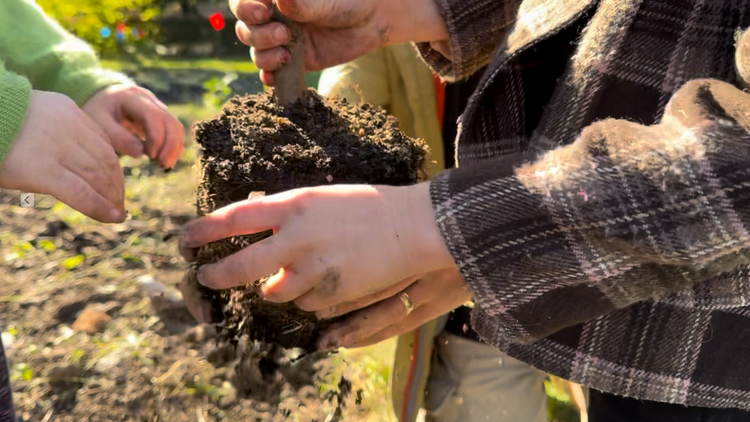We planted Hidden River Little Forest, located at 111 Van Order Drive, in a courtyard serving four different Kingston Frontenac Housing Corporation (KFHC) affordable housing sites and bordering a condominium. Hidden River Little Forest bring 3-30-300 tree equity to all of the residents in the surrounding buildings.
Our community

After experiencing significant social trauma over the past few years, residents involved in the design were committed to transforming the courtyard into a beautiful place for community gatherings. They expressed a strong desire to create a place where all, human and the more-than-human, could find refuge and solace. They look forward to forging healing relationships with those beings.
About the site

The site is located on top an ephemeral stream and, according to older residents, a marsh that was later filled in. During a Jane's Walk conducted by a historian, we learned that the ephemeral stream once ran from Loblaws, winding through Calvin Park and 111 Van Order until it reached Centennial Public School, where it turned and flowed south towards Hatter's Bay. This history inspired the Forest's name.
Due to a 3 metre hydro corridor, the final design divided the forest into two lobes.
About the Forest
Due to the shallow, rocky fill used to cover the marsh and ephemeral stream, we looked to an Alvar for our reference ecosystem. Thankfully Alvars are resilient ecosystems home to a wonderful diversity of trees and shrubs, including Chinqapin Oak (Quercus muehlenbergii), a Carolinian species with edible acorns.

Both sections of the forest were geared towards trees that would do better in shallow soils. In total, we planted 870 trees and shrubs. We also planted an Alvar inspired Pocket Meadow between the two Little Forests.
 We had a great turnout for our plantings, split over two days. On the Saturday, residents and community members planted one of the lobes of the Little Forest. The following week, students from J.R. Henderson, Katarokwi Learning Centre, and Calvin Park planted the second lobe.
We had a great turnout for our plantings, split over two days. On the Saturday, residents and community members planted one of the lobes of the Little Forest. The following week, students from J.R. Henderson, Katarokwi Learning Centre, and Calvin Park planted the second lobe.It was lovely to watch students from Katarokwi Learning Centre, who had learned how to plant the trees earlier in the day, teach students from Calvin Park how to plant and care for the seedlings.
Lessons learned

- Wrap trees instead of applying Bobbex. Despite regular applications of Bobbex, the trees suffered Rabbit predation. Going forward, we'll wrap the trees in winter instead of relying on Bobbex.
- If working with residents of public housing sites, connect with the people who work on the front lines as they're familiar with issues around neighbourhood relations. We had to put the project on hold for a month when the board of a neighbouring condo expressed concerns after receiving a flyer dropped off by residents. Knocking on the door with a personal invitation to early engagement sessions might have prevented the delay as the condo association was excited about the project once they better understood it.
- Community engagement is critical. We had fewer boots on the ground at this site when it came time to prepare and plant, highlighting the need to continue to work on our community engagement process, potentially extending the timeline and seeking new ways to engage.
- Email and text doesn't work for everyone. Some residents aren't online and some don't answer their phones. We need to look at communication strategies, such as word of mouth and phone trees, that match the needs and capacity of the community.
- Take the time for precise measurements, mapping out areas of a site where soil conditions change. During early designs we lacked an understanding of the exact locations where there was fill covering the buried stream, which meant we had to adjust our design late in the process.
- Wetlands have been significantly impacted by humans. Filling in wetlands and covering streams have negatively impacted the soil community, something we need to be mindful of when choosing planting locations, species, and approach.

Thanks
Our heartfelt thanks to the residents of 111 Van Order who helped design the planting, prepare the forest floor, and plant the seedlings. Gratitude as well to staff and students of J.R. Henderson, Katarokwi Learning Centre, and Calvin Park; to Beacon Design Collective and Green Communities Canada for funding this amazing project, and to the City of Kingston for supplying arborist woodchips.

